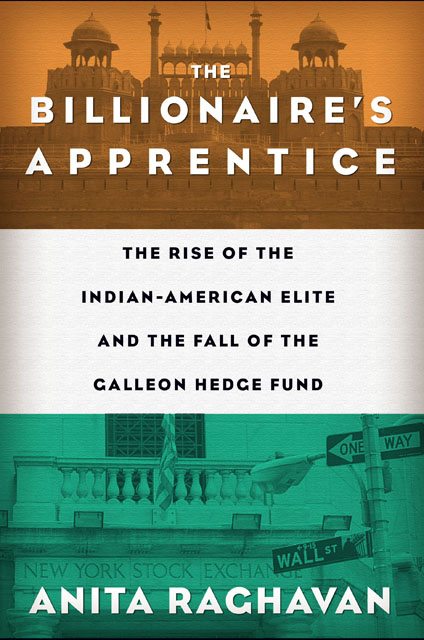
Review: ‘The Billionaire’s Apprentice: The Rise of the Indian American Elite & the Fall of the Galleon Hedge Fund

Anita Raghavan’s new book, The Billionaire’s Apprentice: The Rise of the Indian-American Elite and the Fall of the Galleon Hedge Fund (Grand Central Publishing, June 2013) is an important work for the Indian-American community. Even though the book is primarily a detailed history of the Galleon Hedge Fund scandal, Raghavan paints on a much wider canvas, bringing to life the major characters involved in the context of their journey as South Asians rising to the top in America, and more specifically on Wall Street.
Blind Ambition
She compares and contrasts two men, Raj Rajaratnam and Rajat Gupta, who could not be more different in personality and career trajectory, but who share the common bond of blind ambition that will bring them both down. Rajaratnam, of course, is so extreme as to be a caricature. A very intelligent but morally bereft and hyper-aggressive wheeler-dealer, he spins a web of deception over two decades, roping in bankers, lawyers, industry executives, and even his younger brother, into his schemes of insider trading. Raghavan plays it straight, never judging but giving us straight facts about the man that tell us exactly who he is.
Gupta, on the other hand, is a much more complex character, and at least in the way that the book presents him, a deeply tragic one. Coming from a cultured background in Calcutta, he rises through hard work and smarts to the pinnacle of professional success in America, making pit stops at IIT, Harvard Business School, and McKinsey along the way. Unfortunately, once he gets where he wants to be, represented by his board membership of the venerable Goldman Sachs, Proctor & Gamble, and American Airlines, he falls into the trap of Rajaratnam, whose billion dollar status he secretly covets.
As I discuss in more detail in a review on Huffington Post entitled Corrupt Fortune, it is the lack of something in both their lives that draws Rajaratnam and Gupta together, and ultimately results in a big trade by Galleon in Goldman stock just before the firm receives a $5 billion investment from Warren Buffett. Of course, Rajaratnam’s activities weren’t limited to Goldman stock and the book chronicles how he made a killing by trading AMD, Akamai, Hilton and many other stocks based on inside information. But regardless, the Goldman tip-off puts a nail into Gupta’s coffin and makes his corruption irreversible – at least in the eyes of the law.
Good Guys, Bad Guys
Another fascinating aspect of the book is the investigation that the SEC, and then the US Attorney’s office conducts into Galleon, and Raghavan shows us exactly how they make their case (it’s not easy). Two notable Indians are also present on the other side, personified by Sanjay Wadhwa of the SEC and Preet Bharara of the US Attorney’s office, and they provide a comforting presence for Indian-Americans. The bad guys here might be South Asian but so are the good guys, and that is important to note.
The Indian community in America has certainly ‘arrived’. Indians are everywhere, from finance to politics to media, and they are not just treading water either – they are rising to senior positions and directing the destinies of industries. They are also greatly involved in philanthropic work, not just for the homeland but right here at home as well, and they are truly assimilated into the American culture and values.
And that is what makes Gutpa’s fall even more problematic. He represents everything good about being Indian-American – educated, polished, humble, generous, statesmanlike – and yet his choices later in life throw all that away for the sake of money and in his quest for even higher status.
Rajaratnam, Rajat Gupta & Indian-Americans
Rajaratnam, who has been spectacularly unrepentant and seems to harbor a screwed up sense of ‘honor among thieves’ can be written off easily. He is a bandit at heart and hardly a role model for anyone, Indian or American. But Gupta is a tragedy and should serve as a precautionary tale for all of us. Ambition is a fine thing; it is what has brought all of us here and enabled us to rocket to the top of American society, but blind ambition can drag us down from the heights we scale, and destroy the goodwill that our community has worked so hard to build in our adopted country.
That does not mean, of course that non-Indians do not do unethical things or that Indians are particularly greedy, but my point is that we should still strive to be better than the rest. It would be a tribute to our rich culture if we can adopt the best of American values but reject the poorer ones, and set an example for all communities.
As I said earlier, we should take heart in the fact that the Galleon scandal also yielded just and heroic figures like Bharara, and strive to emulate that. My personal hope is that Gupta himself will use the opportunity that he has been given by the courts (through a very light sentence of two years) to reinvent himself, learn from his mistakes, return to India, and do some real good for the people there. That may not resurrect his earlier iconic status, but it will at least provide inspiration for the next generation of Indians to worry less about ‘arriving’ and concentrate on a meaningful journey instead.
Read Raghavan’s book. It is relentlessly engaging and provides valuable food for thought. You will not be disappointed.

SANJAY SANGHOEE is a political and business commentator. He is a banker, has an MBA from Columbia Business School, and is the author of a new thriller “Killing Wall Street”. For more information, please visit Killingwallstreet.com
Related Articles:
Is There a Negative Bias Towards India by the American Media?
The Dilemma of Looking after Aging Parents
NRI Tales – Becoming Indian in America
Money Games – Rise of the Rich, Fall of the Nation

1 Comment
Hey Sanjay – thanks for a great review. I had an opportunity to read the book and exchanged some emails with Anita as well. To add to this, I think the book is also an opportunity for the Indian American community to embrace a more multifaceted, diverse identity and an honest acceptance of its strengths and weaknesses. Its great that we have achieved so much financial and professional success, but is that where it ends? Are we just going to be another spelling bee champ, Wall St banker, and doctor? Indians are getting caught in all types of scandals recently from insider trading to Medicare fraud to tax evasion. Our community has human frailties and weaknesses like any other and even men of Gupta’s calibre can fall. I think culturally we have a hard time accepting this and being open about this. Hopefully, this book will stimulate the conversation!